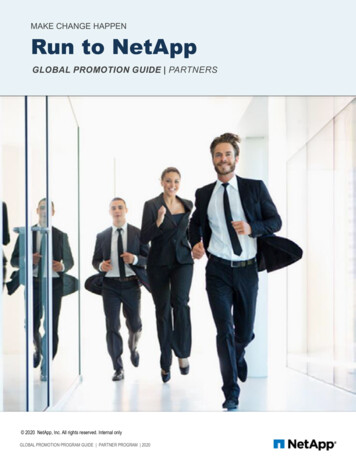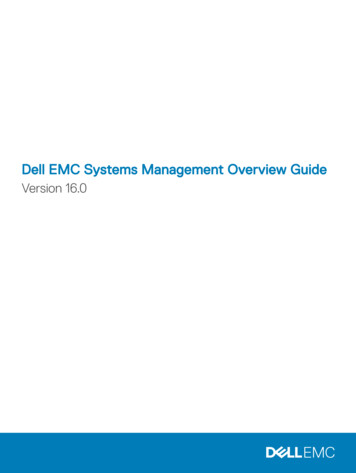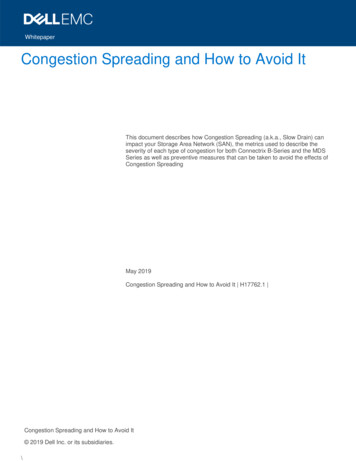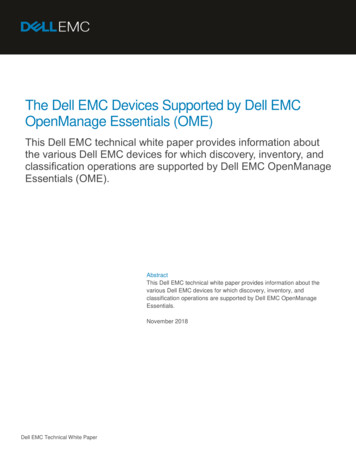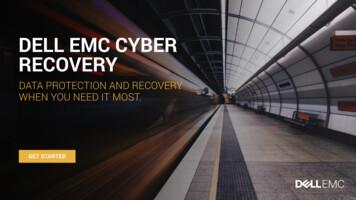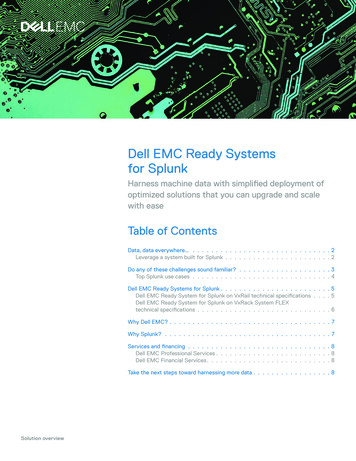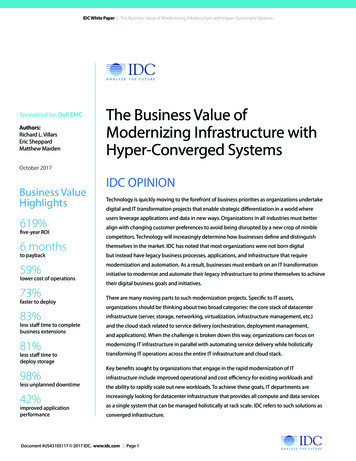
Transcription
IDC White Paper The Business Value of Modernizing Infrastructure with Hyper-Converged SystemsSponsored by: Dell EMCAuthors:Richard L. VillarsEric SheppardMatthew MardenThe Business Value ofModernizing Infrastructure withHyper-Converged SystemsOctober 2017Business ValueHighlights619%five-year ROI6 monthsIDC OPINIONTechnology is quickly moving to the forefront of business priorities as organizations undertakedigital and IT transformation projects that enable strategic differentiation in a world whereusers leverage applications and data in new ways. Organizations in all industries must betteralign with changing customer preferences to avoid being disrupted by a new crop of nimblecompetitors. Technology will increasingly determine how businesses define and distinguishthemselves in the market. IDC has noted that most organizations were not born digitalto paybackbut instead have legacy business processes, applications, and infrastructure that require59%modernization and automation. As a result, businesses must embark on an IT transformationlower cost of operations73%faster to deploy83%initiative to modernize and automate their legacy infrastructure to prime themselves to achievetheir digital business goals and initiatives.There are many moving parts to such modernization projects. Specific to IT assets,organizations should be thinking about two broad categories: the core stack of datacenterinfrastructure (server, storage, networking, virtualization, infrastructure management, etc.)less staff time to completebusiness extensionsand the cloud stack related to service delivery (orchestration, deployment management,81%modernizing IT infrastructure in parallel with automating service delivery while holisticallyless staff time todeploy storage98%and applications). When the challenge is broken down this way, organizations can focus ontransforming IT operations across the entire IT infrastructure and cloud stack.Key benefits sought1 by organizations that engage in the rapid modernization of ITinfrastructure include improved operational and cost efficiency for existing workloads andless unplanned downtimethe ability to rapidly scale out new workloads. To achieve these goals, IT departments are42%increasingly looking for datacenter infrastructure that provides all compute and data servicesimproved applicationperformanceas a single system that can be managed holistically at rack scale. IDC refers to such solutions asconverged infrastructure.Document #US43105117 2017 IDC. www.idc.com Page 1
IDC White Paper The Business Value of Modernizing Infrastructure with Hyper-Converged SystemsThe fastest-growing segment of the converged infrastructure market is known as hyperconverged infrastructure (HCI). Hyper-converged infrastructure is distinguished fromtraditional converged systems in that it natively collapses core storage, compute, and storagenetworking functions into a single software solution or appliance. In addition to integratingstorage and compute functions into a single node (or a cluster of nodes, each offeringcompute and storage functions), hyper-converged infrastructure employs a distributed filesystem or object store for data organization and access, an abstraction mechanism for poolinghardware resources and providing a substrate for workload adjacency. Today’s well-designed,commercially available hyper-converged solutions are based on web-scale architecturesand share attributes of a distributed everything architecture, scale-out design, and analyticsbut don’t require businesses to develop their own new technology stack. Hyper-convergedarchitectures are being used as a platform of choice when building out today’s public andprivate cloud infrastructure as organizations look for fast deployment of IT, reduced time spentmanaging datacenter assets, and easy scale out.IDC believes hyper-converged infrastructure has moved past its early market phase and isnow being leveraged by a large number of organizations for a wide range of uses. In fact,global spending on HCI was more than 2 billion in 2016 and is set to surpass 7.6 billion bythe end of 2021. This striking growth rate is happening because a large and growing numberof companies are deploying HCI solutions to run a mix of workloads, including those that aredeemed mission critical.IDC interviewed organizations that have deployed Dell EMC VxRail and VxRack hyperconverged solutions (collectively referred to as Dell EMC HCI solutions) to support theirexpanding IT and business operations. Study participants reported that Dell EMC HCI solutionsserve as a foundation for innovation across their distributed organizations by providinga cost-effective, agile, and high-performing IT infrastructure foundation. The result is thatthese organizations are realizing a 619% five-year return on their investment in Dell EMC HCIsolutions, which IDC puts at a value of 150,776 per 100 users per year, resulting in a six-monthpayback period. The use of Dell EMC HCI facilitates innovation across study participants’business operations by: Enabling staff and business operations with high-performing business applications andservices at noncentral locations Providing an agile infrastructure that enables the business and requires less staff time todeploy (73%) and support (51%) Causing fewer impactful outages (98% less unplanned downtime) Costing almost one-quarter (22%) less than comparable infrastructure approachesconsideredDocument #US43105117 2017 IDC. www.idc.com Page 2
IDC White Paper The Business Value of Modernizing Infrastructure with Hyper-Converged SystemsTECHNOLOGY IS DRIVING THE NEXTWAVE OF BUSINESS INNOVATIONDigital transformation (DX) is the process of creating value, growth, and competitiveadvantage through new offerings, business models, and business relationships. It’s aboutchanging the way that business gets done.That change begins in the datacenter and requires that companies first undergo an ITtransformation (ITX) — the conversion of the IT organization from being the back-officeenabler of internal business processes to playing a prominent role as the engine poweringdigital business.IDC finds that leaders in driving this critical IT transformation focus on three goals: Modernizing the core IT infrastructure to meet exponential increases in the performanceand scale of critical systems of record without sacrificing integrity, security, or reliability Automating the provisioning and delivery of IT resources through adoption of cloudbased operating models to speed time to develop, deploy, and upgrade existing systemsof engagement and insight at the heart of digital transformation Transforming the IT organization and processes to enable the IT team to drive newthinking around becoming a driver of innovation and ensure that transformation effortsare complementary, resilient, scalable, and secureSuccess in digital transformation also requires new thinking about the creation, analysis, andconsumption of data not only at the core of the business but also at increasingly “smart” edgelocations, such as hospitals, factories, and transportation hubs, where businesses connect withpeople or “smart” things.To enable an agile environment across core and edge, IT leaders are modernizing theirdatacenters with scalable hyper-converged systems to provide standardized hardware andsoftware-defined infrastructure without sacrificing performance or reliability.Document #US43105117 2017 IDC. www.idc.com Page 3
IDC White Paper The Business Value of Modernizing Infrastructure with Hyper-Converged SystemsBUSINESS VALUE OF DELL EMC HCISOLUTIONSInterviewed Dell EMC customers reported that they are leveraging Dell EMC’s HCI solutionsto meet business demand for innovation and performance across their organizations. Studyparticipants have leveraged this flexibility to both capture more revenue and increase theproductivity levels of employees, as described in this study. One study participant explained:“We’re seeing benefits for our manufacturing with VxRail because some of those systems have to berun on location.” Another IT manager commented on the agility VxRail enables: “VxRail costs abouthalf as much as the other solution we considered, and we trust the VxRail solution. So we’re gettingthe ability to deploy quickly at a low cost point.”Firmographics of Study ParticipantsThe seven interviewed organizations varied in size and scope of operations ranging fromseveral hundred employees to over 20,000 employees, with an average of 7,417 employees(see Table 1). Interviews for the study reflected experiences of Dell EMC customers in NorthAmerica, EMEA, and APAC and the experiences of retailers, public sector organizations, highereducation institutions, and software developers. These organizations all have distributedoperations across locations or buildings, requiring them to deliver applications and IT servicesbeyond their core locations. At the time the interviews were conducted, study participantswere using an average of two Dell EMC HCI machines with 10 servers and running over 60business applications on this infrastructure.TABLE 1 Demographics and Dell EMC Scale-Out Solution Use byInterviewed OrganizationsAverageMedian7,4173,750Number of IT staff13330Number of business applications159100 1.8 billion 800 millionNumber of VxRail/VxRack servers108Number of VxRail/VxRack business applications6115Number of users of applications on VxRail/VxRack1,451938Number of terabytes, VxRail/VxRack environment9350Number of employeesRevenue per yearCountriesUnited States, Germany, AustraliaIndustriesHigher education, public sector, retail, software developmentn 7Source: IDC, 2017Document #US43105117 2017 IDC. www.idc.com Page 4
IDC White Paper The Business Value of Modernizing Infrastructure with Hyper-Converged SystemsQuantifying the Value of Dell EMCScale-Out SolutionsDell EMC customers reported that their use of VxRail and VxRack is helping them innovateand become more operationally efficient across their business environments. As a result, theyare realizing strong value by supporting distributed business applications with Dell EMC HCIsolutions (see Figure 1). IDC calculates this value at an annual average of 150,776 per 100users, with organizations on average realizing 2.19 million per year in benefits in the followingareas: Business productivity benefits. Study participants are winning more business andenabling employees across their distributed operations. IDC calculates that studyparticipants will realize revenue and employee productivity gains worth an average of 77,342 per 100 users per year ( 1.12 million annually per organization). IT staff productivity benefits. Study participants are benefiting from the ease ofdeploying, maintaining, and supporting their Dell EMC HCI solutions, as well as efficienciesfrom using the solution as a development platform. IDC puts the value of related timesavings and productivity gains at an average of 34,571 per 100 users per year ( 501,600annually per organization). Risk mitigation — user productivity benefits. Study participants are experiencing fewerimpactful application and system outages and resolving such situations faster. The resultis the reduction, by 98%, of lost productive time and lost revenue caused by unplanneddowntime, which IDC estimates will have a value of 31,068 per 100 users per year( 450,800 annually per organization) on average. IT infrastructure cost reductions. Study participants are spending less on their DellEMC HCI solutions than on their legacy or alternative infrastructure environments. IDCcalculates that they will save an average of 7,795 per 100 users per year ( 113,100annually per organization).Document #US43105117 2017 IDC. www.idc.com Page 5
IDC White Paper The Business Value of Modernizing Infrastructure with Hyper-Converged SystemsFIGURE 1 Average Annual Benefits per 100 Users160,000 7,795140,000 31,068( per 100 users)120,000100,000 34,57180,00060,00040,000 77,34220,0000BusinessProductivitybenefitsIT staffproductivitybenefitsRisk mitigation –user productivitybenefitsIT infrastructurecost reductionsAverage Annual Benefits: 150,776 per 100 usersSource: IDC, 2017Business Productivity Benefits: Delivering Performance and valueat the EdgeDell EMC HCI solutions are helping interviewed organizations innovate and drive business.With varied locations, these organizations require a modern IT infrastructure that canensure the reliability, scalability, and performance of applications and services across theirorganizations. In turn, this helps the organizations become more operationally efficient andeffective, and it supports the delivery of better business resultsReliability, Scalability, and Performance Across LocationsStudy participants cannot maximize their business potential without an IT infrastructure thatallows them to operate at full velocity across their locations. This means that IT infrastructuresolutions —located centrally, either onsite or in the cloud — that cannot deliver the neededlevels of IT performance and agility will not be sufficient. When performance and agility arelacking, organizations cannot be sure that they will be able to respond to business demandsor opportunities and risk losing business opportunities or incurring operational inefficienciescaused by this IT-related friction.Interviewed Dell EMC customers reported that their HCI solutions have delivered higherreliability, performance, and agility. As shown in the sections that follow, the improvementsand efficiencies have been substantial, serving to enable these organizations, especially inlocations where they are operating Dell EMC HCI solutions.Document #US43105117 2017 IDC. www.idc.com Page 6
IDC White Paper The Business Value of Modernizing Infrastructure with Hyper-Converged SystemsReliabilityStudy participants need business applications and services to be available to support theircustomers and employees, and they are experiencing 83% fewer impactful unplannedoutages, which has translated to 98% less unplanned downtime since deploying Dell EMCHCI solutions (see Table 2). One organization explained the criticality for high availability:“Higher reliability has been a big win for us because we provide emergency services, and we need itto be working.”TABLE 2 Dell EMC HCI Impact on Unplanned DowntimeBefore/WihtoutDell EMC HCIWithDell EMC HCIDifferenceChange (%)Unplanned outages per year per organization5.50.94.683MTTR (hours)2.50.22.392Hours per user of lost productivity per year5.00.14.998FTE impact, lost user productivity per year3.80.13.798n 7Source: IDC, 2017PerformanceImproved performance in terms of latency (42% improved application performance onaverage) and time to execute processes (39% faster execution of batch processes) benefitsusers of applications (see Figure 2). One interviewed Dell EMC customer noted: “The biggestbenefit is that the responsiveness of the system is greatly increased because of how much more IOPSthe back end has now compared [with] our previous system.”FIGURE 2 Dell EMC HCI Impact on Performance42%Improved application performanceFaster execution of business transactions39%Faster to run batch process39%71%Source: IDC, 2017Document #US43105117 2017 IDC. www.idc.com Page 7(% of improvement)
IDC White Paper The Business Value of Modernizing Infrastructure with Hyper-Converged SystemsAgilityThe impact of Dell EMC HCI solutions has been most evident in terms of time to get thesolution itself up and running (73% less staff time on average among study participants),deploy storage (81% less staff time), and provision new servers (64% faster deployment) (seeFigure 3). In turn, this helps the organizations execute business extensions with one-sixth thestaff time compared with their legacy environments (83% less staff time on average). OneVxRail customer referenced how these efficiencies help it: “With VxRail, we’re able to respond todemand from the business much quicker. If the system needs more space, compute, or RAM, we havethe resources to do that now . When people need things, it’s almost instantaneous.”FIGURE 3 Dell EMC HCI Impact on IT and Business Agility83%Less staff time per business extension81%Less staff time to deploy storage73%Less staff time to deploy, Dell EMC HCI71%Faster to deploy, new server64%62%Faster to deploy, storageSource: IDC, 2017(% of improvement)Supporting Business and Operational ExpansionSource:IDC, 2017 performance, and scalability with their DellStudy participants have leveragedreliability,EMC HCI solutions to create value in the form of higher revenue and increased employeeproductivity (see Table 3). With VxRail and VxRack deployed, these organizations can put inplace IT resources as needed to address business opportunities and ensure that employees —especially outside of central locations — have consistent access to high-performing businessapplications.Dell EMC HCI solutions have helped study participants increase revenue by both betteraddressing business opportunities and reducing revenue lost during outages. One studyparticipant explained how VxRail helps it win more business: “With VxRail, we are able to keepup with business demand at our sites. If we couldn’t, it would be very impactful to manufacturingand shipping. Now, we are able to run additional warehousing shifts. I would say that it’s millions ofdollars per year in additional revenue, but it could be a lot more.”Document #US43105117 2017 IDC. www.idc.com Page 8
IDC White Paper The Business Value of Modernizing Infrastructure with Hyper-Converged SystemsMeanwhile, improved performance also has a significant impact on how employees, especiallyat noncentral locations, work. Efficient and timely delivery of high-performing businessapplications helps them increase productivity levels. One study participant commented: “Theapplications running on VxRail are performing tremendously better . Normal queue times were15–20 milliseconds before, and I now see 0.1 milliseconds on my storage queue times. So storageproblems are no longer an issue, and there are no longer bottlenecks.”TABLE 3 Business Productivity BenefitsPer OrganizationPer 100 UsersAdditional revenue per year 421,100 29,024Recognized revenue per year — IDC model* 63,200 4,354 1.2 million 85,785 186,700 12,868Number of users impacted25217Equivalent FTE gain9.90.7 363,000 25,021Revenue impact due to better addressing business opportunitiesRevenue impact due to unplanned downtimeAdditional revenue per yearRecognized revenue per year — IDC model*User productivity impactOther operational cost reductions per year* The IDC model assumes a 15% operating margin for all additional revenue.Source: IDC, 2017Expanding in an Operationally Efficient MannerStudy participants noted that in addition to enabling their businesses, Dell EMC HCI solutionshave facilitated operations in a cost-effective and efficient manner. IDC projects that onaverage, these organizations will operate their Dell EMC HCI solutions at a five-year cost ofoperations that is 59% lower than that of their legacy or alternative environment, helping themjustify improving IT performance and agility across their organizations (see Figure 4).Document #US43105117 2017 IDC. www.idc.com Page 9
IDC White Paper The Business Value of Modernizing Infrastructure with Hyper-Converged SystemsFIGURE 4 Five-Year Cost of Operations( per 100 users over five years)600,000500,000 479,735 92,600400,00059% lower300,000 307,400 198,500200,000 135,100100,000 1,600User productivity costsand unplanned downtimeIT staff time costs 79,700 61,800Before/withoutDell EMC HCIWithDell EMC HCI0IT infrastructure-related costsSource: IDC, 2017IT Infrastructure Cost Reductions: Cost-Effective IT PlatformDell EMC customers reported spending less on hardware and related maintenance and powerto operate their HCI environments — 22% less — than they otherwise would have. Deployinga hyper-converged platform often means requiring fewer servers and network storagehardware, while the consolidated and efficient nature of the hyper-converged solutions reducesspending on power and space. Further, the organizations are capturing these cost efficiencieseven as they take advantage of much increased flash storage capacity to drive performanceimprovements — going from an average of almost no flash storage to 61TB with Dell EMC HCI.One study participant commented on cost-related efficiencies it has seen with Dell EMC: “We’rebenefiting from the simple fact that there is now more capacity, power, compute, and bandwidth.We’re able to do more. To replace the system with multiple hosts, plus a SAN and a communicationnetwork, would cost significantly more and would have taken longer to get up and running.”IT Staff Productivity BenefitsMoving to a consolidated hyper-converged environment with Dell EMC HCI solutions has alsoenabled IT staff efficiencies for interviewed organizations. These efficiencies are being achievedacross the life cycle, from deployment to ongoing management and ongoing support. In total,study participants reported needing less than half the staff time (56% less) to deploy and runtheir Dell EMC HCI datacenter environments (see Table 4). In particular, they are benefiting fromsoftware-defined processes that build in automation, high reliability, and the ability to managesingle pools of compute and storage resources rather than more siloed environments.Document #US43105117 2017 IDC. www.idc.com Page 10
IDC White Paper The Business Value of Modernizing Infrastructure with Hyper-Converged SystemsTABLE 4 IT Staff Productivity Benefits per 100 Users Over Five YearsBefore/WihtoutDell EMC HCIFTEsWithDell EMC HCIDifferenceBenefit (%)Deployment0.090.020.0773Management, keeping the lights on0.690.220.4768Management, .491.9056n 7Source: IDC, 2017ROI AnalysisIDC based the ROI analysis on interviews with organizations that are using Dell EMC VxRailand/or VxRack solutions to run applications at noncentral locations in their disparatebusiness operations. Based on these interviews, IDC calculated the benefits and costs to theseorganizations of deploying and running Dell EMC HCI solutions. IDC used the following threestep method for conducting the ROI analysis: 1. Gathered quantitative benefit information during the interviews using a beforeand-after assessment of the impact of VxRail/VxRack. In this study, the benefits includedrevenue gains, operational efficiencies, staff time savings and productivity benefits, andIT-related cost reductions. 2. Created a complete investment (five-year total cost analysis) profile based on theinterviews. Investments go beyond the initial and annual costs of using VxRail/VxRack andcan include additional costs related to migrations, planning, consulting, and staff or usertraining. 3. Calculated the ROI and payback period. IDC conducted a depreciated cash flow analysisof the benefits and investments for the organizations’ use of Dell EMC HCI solutions overa five-year period. ROI is the ratio of the net present value (NPV) and the discountedinvestment. The payback period is the point at which cumulative benefits equal the initialinvestment.Table 5 presents IDC’s analysis of the benefits and costs of using Dell EMC HCI solutionsfor study participants. IDC projects that on average, these Dell EMC customers will invest adiscounted total of 74,951 per 100 users over five years ( 1.09 million per organization).Document #US43105117 2017 IDC. www.idc.com Page 11
IDC White Paper The Business Value of Modernizing Infrastructure with Hyper-Converged SystemsIDC expects that in return, the organizations will realize discounted benefits with a value of 539,059 per 100 users over five years ( 7.82 million per organization). This would result in afive-year ROI of 619% and breakeven on their investment in six months.TABLE 5 ROI AnalysisFive-Year Average per Organization Five-Year Average per 100 UsersBenefit (discounted) 7.82 million 539,059Investment (discounted) 1.09 million 74,951Net present value (NPV) 6.73 million 464,108619%619%6 months6 months12%12%Return on investment (ROI)Payback periodDiscount rateSource: IDC, 2017CHALLENGES/OPPORTUNITIES FORDELL EMCSmaller HCI vendors have long viewed HCI technology as a viable platform for mission-criticalworkloads and have worked diligently to expand the capabilities and feature set of their HCIsolutions. Some larger vendors have recently increased their share within the HCI market.Importantly, IDC sees a disconnect between the expanded number of workloads (includingthose that are considered mission critical) running on HCI solutions and the general perceptionthat HCI technology is still useful only for very specific/limited environments (most notablyVDI, remote offices, or branch offices). Any vendor with current product strategies based on anoutdated perception of HCI will find itself in an increasingly weaker competitive position.Dell’s biggest evolution in the HCI market is its acquisition of EMC, which was completed inSeptember 2016. This acquisition allows the newly formed Dell EMC to span the entire storagemarket, from small and medium-sized businesses (SMBs) to large enterprises, with a wideproduct portfolio. To take advantage of its strengths and maintain its market position, Dell EMCwill have to continue to emphasize its product portfolio, sales force, and installed base.Document #US43105117 2017 IDC. www.idc.com Page 12
IDC White Paper The Business Value of Modernizing Infrastructure with Hyper-Converged SystemsCONCLUSIONThe impact of HCI on the IT organization is significant. Time that was previously spentconfiguring individual compute, storage, and network elements as well as time spent makingsure all the pieces worked together can now be spent on tasks and projects that directly driveinnovation within the datacenter. Rack-level HCI solutions are more extensively instrumentedand automated, allowing IT departments to move one step closer to lights-out operations andposition themselves for moving forward in the IT transformation journey. The most efficient andexpedient way to jump-start any organization’s IT transformation effort is through modernizingthe datacenter with HCI. Time that was previously spent implementing and maintainingsystems can now be spent on providing innovative IT services that move the business forward.APPENDIXMethodologyIDC’s standard ROI methodology was utilized for this project. This methodology is based ongathering data from current users of VxRail and/or VxRack infrastructure solutions as thefoundation for the model. Based on interviews with seven organizations using these Dell EMCHCI solutions, IDC performed a three-step process to calculate the ROI and payback period: Measure the benefits from the use of Dell EMC HCI solutions in terms of IT infrastructurecost savings and avoidances; IT staff time savings and productivity gains; user productivitygains; and revenue attributed to the use of Dell EMC HCI solutions. Ascertain the investment made in deploying VxRail and/or VxRack and associatedmigration, training, and support costs. Project the costs and savings over a five-year period and calculate the ROI and payback forDell EMC HCI solutions.IDC bases the payback period and ROI calculations on assumptions that are summarized asfollows: Time values are multiplied by burdened salary (salary 28% for benefits and overhead)to quantify efficiency and productivity savings. IDC assumes a fully burdened salary of 100,000 per year for IT staff, including developers, and 70,000 for other employees, withan assumption of 1,880 hours worked per year. Downtime values are a product of the number of hours of downtime multiplied by thenumber of users affected.Document #US43105117 2017 IDC. www.idc.com Page 13
IDC White Paper The Business Value of Modernizing Infrastructure with Hyper-Converged Systems The impact of unplanned downtime is quantified in terms of impaired end-userproductivity and lost revenue. Lost productivity is a product of downtime multiplied by burdened salary. The net present value of the five-year savings is calculated by subtracting the amount thatwould have been realized by investing the original sum in an instrument yielding a 12%return to allow for the missed opportunity cost. This accounts for both the assumed cost ofmoney and the assumed rate of return.Because every hour of downtime does not equate to a lost hour of productivity or revenuegeneration, IDC attributes only a fraction of the result to savings. As part of our assessment, weasked each company what fraction of downtime hours to use in calculating productivity savingsand the reduction in lost revenue. IDC then taxes the revenue at that rate.Further, because IT solutions require a deployment period, the full benefits of the solution arenot available during deployment. To capture this reality, IDC prorates the benefits on a monthlybasis and then subtracts the deployment time from the first-year savings.Note: All numbers in this document may not be exact due to rounding.IDC Global Headquarters5 Speen StreetFramingham, MA 01701USA508.872.8200Twitter: @IDCidc-insights-community.comwww.idc.comCopyright NoticeInformation and Data — Any IDCAbout IDCinformation that is to be usedInternational Data Corporation (IDC) is the premier global provider of marketin advertising, press releases, orintelligence, advisory services, and events for the information technology,External Publication of IDCpromotional materials requires priorwritten approval from the appropriatetelecommunications and consumer technology markets. IDC helps IT professionals,IDC Vice President or Countrybusiness executives, and the investment community make fact-based decisions onManager. A draft of the proposeddocument should accompany anytechnology purchases and business strategy. More than 1,100 IDC analysts p
The fastest-growing segment of the converged infrastructure market is known as hyper-converged infrastructure (HCI). Hyper-converged infrastructure is distinguished from traditional converged systems in that it natively collapses core storage, compute, and storage networking functions into a single software solution or appliance.





